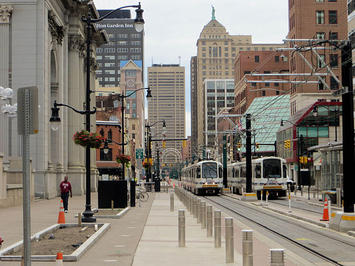
You may recall my City Journal feature on Buffalo from 2015. This was written about the time New York Gov. Andrew Cuomo’s Buffalo Billion program – a pledge to spend $1 billion in state funds to bring back the city economically – was in the earlier stages of development.
Fast forward, and Cuomo’s Buffalo Billion chief Alain Kaloyeros and Buffalo construction magnate Louis Ciminelli were recently convicted on corruption charges. A lot of the heavy lifting journalistically that raised questions about the Buffalo Billion was done by Jim Heaney and his team at the Investigative Post.
As this was ongoing, the New York Times did an analysis of whether the Buffalo Billion was living up to the hype. They found mixed results and an overall underwhelming program to date:
But an examination of the plans and progress of projects included in the Buffalo Billion reveals a far more uneven return on investment to date: a mix of street-level successes, expensive brick-and-mortar gambles and ill-conceived misfires.
While some projects have bloomed, others have been delayed by years or show no sign of progress, beyond their initial news release. And Mr. Cuomo’s promises of well-paying, permanent jobs at the most costly projects have repeatedly fallen well short….“I think the Buffalo Billion sounds better than it probably turned out to be,” said Isaac Ehrlich, a SUNY distinguished professor of economics at the University at Buffalo.
…
“The last seven years have undoubtedly been the best in Buffalo for a very long time,” said Howard Zemsky, the president of Empire State Development, the state’s primary economic development agency. “And I don’t think it’s coincidental that the way the governor transformed economic development has had a very positive impact.”Mr. Zemsky noted some 25,000 new private sector jobs have come to the city during the Cuomo administration, and added that many of the Buffalo Billion projects — both past and future — were not exclusively about jobs, per se, but support for long-term solutions like downtown revitalization, smart growth, opening up the waterfront and keeping younger generations from fleeing.
…
Still, the governor’s rhetoric has often proved overblown: At Riverbend, a state-funded $750 million solar plant, Mr. Cuomo promised at least 3,000 jobs. Tesla, which runs the plant, now employs about a fifth of that number — between 600 and 700 employees — working with Panasonic, which is a subtenant. And last month, amid concerns about its solar operations, Tesla said that it would trim its work force by nearly 10 percent, though it is not clear if Riverbend’s work force will suffer.At an I.B.M. “innovation hub” where the governor said 500 people would be employed in information technology jobs, the actual number is about half that, according to company officials, with many working for subcontracted agencies and earning between $30,000 to $40,000 a year.
In Niagara Falls, the Wonder Falls resort, a planned $150 million project that includes an indoor water park and 300-room hotel, was to create “1,500 direct and indirect jobs” during construction, and 300 more permanent positions, the governor said in 2013.
The project, however, hasn’t even broken ground; an empty former mall and a parking garage remain on the site, though state and company officials said it is still in the works.
When I looked at Buffalo for my article, the impression I got – which I should point out no one said explicitly – was that Cuomo, looking for a signature upstate economic development initiative, found the recently completed Western New York Regional Economic Development Strategic Plan from 2011 and seized on it, redirecting it for his own purposes. I though the original plan created by regional leaders was good, but you’ll note it doesn’t directly map to some of the Buffalo Billion key initiatives. The original plan doesn’t include anything about subsidizing major manufacturing plants, for example. To the extent that things went sideways with some of this, I would look to the Cuomo people, not local Buffalo leaders who put together a pretty strong plan of their own.
I noted in my piece that the size of the Solar City plant created reputational risk to the city if anything went wrong. The headlines about corruption and underwhelming performance at Solar City are an example of this coming to light.
That’s a shame because a lot of good things have been happening in Buffalo. Howard Zemsky is always in the press because he heads the state’s economic development agency. Properly so, he’s repping their work. But you don’t hear much about the Larkinville development that he spearheaded, which includes a really fantastic renovation of a large former industrial complex. That’s much more significant than sound bites about Empire State Development.
Similarly there are great activities in the neighborhoods, and some of the demographic and economic stats I’ve seen have been somewhat positive, particularly relative to upstate.
It’s unfortunate that this corruption scheme and some ill-advised crony capitalism are detracting from on the ground reinvention happening in a city that does have strategic reason for long term optimism about its prospects.
This piece originally appeared on Urbanophile.
Aaron M. Renn is a senior fellow at the Manhattan Institute, a contributing editor of City Journal, and an economic development columnist for Governing magazine. He focuses on ways to help America’s cities thrive in an ever more complex, competitive, globalized, and diverse twenty-first century. During Renn’s 15-year career in management and technology consulting, he was a partner at Accenture and held several technology strategy roles and directed multimillion-dollar global technology implementations. He has contributed to The Guardian, Forbes.com, and numerous other publications. Renn holds a B.S. from Indiana University, where he coauthored an early social-networking platform in 1991.
Photo: Buffalo Light Rail at Fountain Plaza by David Wilson from Oak Park, Illinois, CC BY 2.0












